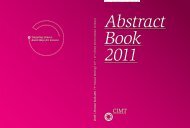Abstract Book 2010 - CIMT Annual Meeting
Abstract Book 2010 - CIMT Annual Meeting
Abstract Book 2010 - CIMT Annual Meeting
You also want an ePaper? Increase the reach of your titles
YUMPU automatically turns print PDFs into web optimized ePapers that Google loves.
098 Trad | Tumor biology & interaction with the immune system<br />
Tumor infiltrating CD11c+ dendritic cells suppress T cell<br />
activation<br />
Malika Trad 1 , Jennifer Fraszczak 1 , Daniela Lakomy 1 , Maxime Samson 1 , Sylvain Audia 1 ,<br />
Julien Vinit 1 , Emmanuel Katsanis 2 , Nicolas Larmonier 2 * and Bernard Bonnotte 1<br />
1 CR INSERM 866, Université de Bourgogne, Dijon, France<br />
2 Department of Pediatrics, Steele Children’s Research Center, University of Arizona, Tucson, USA<br />
* Equal contribution<br />
Many tumors, including breast cancers are infil-<br />
trated by dendritic cells (DC), known primarily for<br />
their capability to induce and sustain anti-tumoral<br />
immune responses. However, a significant deficit<br />
in the function of DC has been reported in cancer<br />
patients and in various animal tumor models,<br />
which may account for tumor escape from the<br />
immune system. Using the murine breast cancer<br />
model 4T1, we have investigated the phenotypical<br />
and functional characteristics of tumor-infiltrating<br />
DC (TIDC). Our results indicate that TIDC, isolated<br />
from 4T1 tumor-bearing Balb/c mice based on the<br />
expression of the marker CD11c, exhibit a mixed<br />
phenotype associating the expression of mature DC<br />
markers (co-stimulatory molecules) and the Gr-1<br />
molecule (a marker of immunosuppressive myeloid<br />
cells). Functionally, TIDC were unable to induce<br />
allogeneic T cell proliferation and produced low<br />
amount of the pro-inflammatory cytokine IL-12,<br />
required for the T cell activation. Conversely, TIDC<br />
secreted the immunosuppressive cytokine IL-10<br />
and were capable of suppressing the proliferation<br />
of T lymphocytes induced with anti-CD3 and anti-<br />
CD28. The mechanism(s) underlying T cell suppression<br />
by TIDC did not depend on nitric oxide,<br />
but may involve the enzyme indoleamine 2,3-dioxygenase<br />
(IDO) which was significantly upregulated<br />
in these cells.<br />
147



